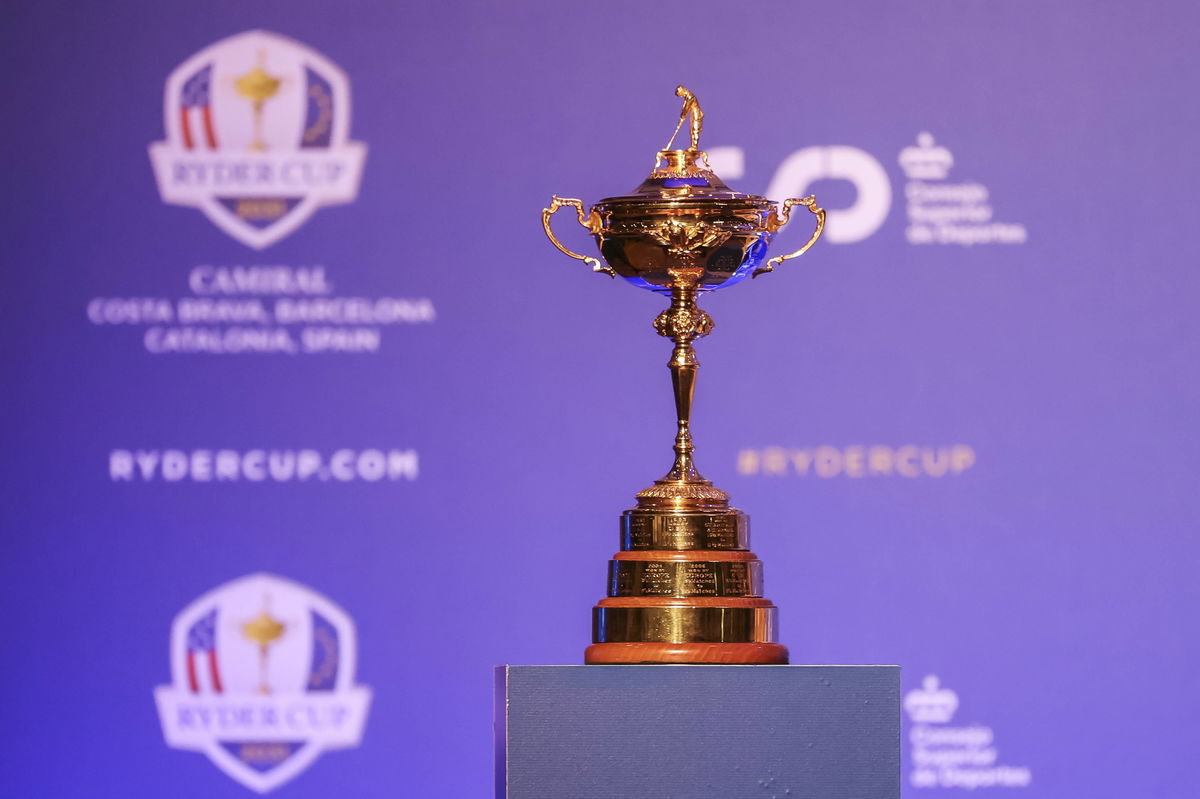
Imago
July 25, 2025, Caldes De Malavella, Girona, SPAIN: View trophy during the presentation Ryder Cup 2031 at Camiral Golf & Wellness on July 25, 2025 in Caldes de Malavella, Girona, Spain. Caldes De Malavella SPAIN – ZUMAa181 20250725_zaa_a181_052 Copyright: xJavierxBorregox

Imago
July 25, 2025, Caldes De Malavella, Girona, SPAIN: View trophy during the presentation Ryder Cup 2031 at Camiral Golf & Wellness on July 25, 2025 in Caldes de Malavella, Girona, Spain. Caldes De Malavella SPAIN – ZUMAa181 20250725_zaa_a181_052 Copyright: xJavierxBorregox
The Ryder Cup trophy stands as one of golf’s most recognizable symbols, watched by millions during biennial competitions. However, few fans know the competition gets its name from Samuel Ryder, an English businessman and seed merchant. Moreover, Ryder didn’t even play his first round of golf until just before his 50th birthday. Furthermore, this late-blooming golfer became so passionate about the sport that he commissioned the trophy in 1926.
Watch What’s Trending Now!
The golfer frozen in mid-swing has long sparked curiosity, while debates over the trophy’s material continue among fans. Behind its creation lies a story of friendship, illness, and one man’s vision, making the Ryder Cup trophy far more than just a sporting prize.
Top Stories
Cheating Allegations Erupt as Scottie Scheffler Narrowly Beats Rory McIlroy at Golf Channel Games

Rory McIlroy’s Disastrous Shot Hits Shane Lowry at Golf Channel Games

Scottie Scheffler Makes Critical Health Announcement After He Ended PGA Tour Hiatus

PGA Tour Event at Risk of Cancellation as $4.7 Billion Sponsor Ends Decade-Long Partnership

Concerns Arise as Amanda Balionis Says She’s Exhausted After Demanding Golf Schedule

ADVERTISEMENT
Who Is the Golfer on the Ryder Cup Trophy? Abe Mitchell’s Legacy
The golfer immortalized on the Ryder Cup trophy is Abe Mitchell, a British professional who ironically never played in the competition. Mitchell was Samuel Ryder’s personal golf instructor and close friend during the 1920s. Furthermore, he was selected for the original 1927 British team but fell ill before the inaugural matches.
Despite missing the historic first Ryder Cup, Ryder specifically requested Mitchell’s likeness grace the trophy. Therefore, Mitchell achieved golfing immortality without ever competing in the event he now symbolizes. Additionally, his elegant swing pose has inspired countless golfers for nearly a century.
Mitchell enjoyed a distinguished career beyond his trophy fame, winning multiple professional tournaments throughout Britain. Nevertheless, his greatest legacy remains his permanent place at the top of golf’s most coveted team prize.
ADVERTISEMENT
Is the Ryder Cup Trophy Made of Gold? Materials, Value, and Specs
The Ryder Cup trophy’s composition remains a subject of ongoing debate among golf historians and collectors. Some sources describe Ryder’s original commission as a “gold trophy,” while others specify it as silver-gilt construction. Moreover, the distinction between solid gold and gold-plated materials creates confusion about the trophy’s true value.
ADVERTISEMENT
Samuel Ryder paid approximately £250 for the trophy in 1926, equivalent to roughly $18,000 in today’s currency. Furthermore, this substantial investment reflected the businessman’s commitment to creating a lasting symbol of international golf competition. Additionally, the 17-inch tall trophy features a cup at the top with intricate detailing throughout its construction.
Meanwhile, the trophy’s specifications reveal careful attention to both aesthetics and durability. The piece stands smaller than major championship trophies but commands equal respect within golf’s hierarchy. Therefore, its compact size belies its enormous significance in professional golf’s team competitions. Consequently, many consider it the most important trophy in golf despite its modest dimensions.
Contrary to popular belief, the Ryder Cup trophy is not made of solid gold. Instead, the 17-inch tall masterpiece consists of silver-gilt construction with gold plating over a silver base. Furthermore, this combination provides durability while maintaining the trophy’s luxurious appearance.
ADVERTISEMENT
View this post on Instagram
The renowned London silversmiths Mappin & Webb crafted the original trophy in 1927 for approximately £250. Moreover, that cost translates to roughly $15,000 in today’s currency, reflecting its substantial value even then. Additionally, the four-pound trophy features intricate engravings depicting golfers in action around its circumference. Two ornate handles extend from either side of the cup portion, while Mitchell’s figure crowns the entire piece. Therefore, every design element contributes to the trophy’s timeless elegance and sporting significance.
The trophy’s base contains plaques listing every winning team and year since 1927. Moreover, these additions create a comprehensive historical record of the competition’s evolution. Furthermore, the silver-gilt construction ensures the trophy maintains its luster despite frequent handling and display.
ADVERTISEMENT
Intricate engravings around the cup portion showcase various golfing scenes and poses. Additionally, the craftsmanship reflects the high standards expected from Mappin & Webb’s skilled artisans. Therefore, every detail contributes to the trophy’s status as a masterpiece of sporting art.The trophy’s proportions create perfect visual balance, with Mitchell’s figure providing an elegant focal point. Meanwhile, the substantial base ensures stability during presentation ceremonies and team celebrations.
History and Creation of the Ryder Cup Trophy
Samuel Ryder’s journey from successful seed merchant to golf patron began remarkably late in his life. The Manchester-born businessman relocated to St. Albans, just outside London, where he served as mayor and justice of the peace. Moreover, golf was introduced to him as a remedy to slow his frenetic work pace. Therefore, his late start in the sport makes his eventual impact even more extraordinary.
ADVERTISEMENT
Ryder quickly became passionate about golf and served on his local club’s greens committee for two decades. Additionally, he frequently funded British golfers and organized tournaments to help them compete with their American counterparts. Furthermore, his financial backing proved crucial during the sport’s early international development. Consequently, Ryder became the driving force behind formalizing transatlantic golf competition.
The first attempt at organized competition occurred in 1926 at Wentworth Golf Club. However, a strike impacted travel into the country, forcing the American side to field replacement players. Therefore, the following year’s event at Worcester Country Club in Massachusetts became the first official Ryder Cup. Meanwhile, the Americans dominated that inaugural competition, winning decisively 9.5-2.5.
Ryder remained the tournament’s organizer and financial backer until his death in 1936 at age 77. Additionally, his vision survived World War II thanks to Robert Hudson, an American grocer from Portland, Oregon. Furthermore, Hudson single-handedly funded the 1947 revival, covering the British team’s entire trip, including their boat passage and cross-country travel. Ultimately, Ryder’s legacy transformed informal matches into golf’s greatest team competition.
ADVERTISEMENT
The Ryder Cup trophy embodies nearly a century of golf history, friendship, and international sporting rivalry. Samuel Ryder’s vision transformed casual matches into golf’s most prestigious team competition, while his personal relationships shaped every detail. Moreover, the trophy’s materials and construction reflect the substantial investment Ryder made in golf’s future.
Today’s golfers compete not just for victory, but for their place in sporting history alongside legends. Meanwhile, Abe Mitchell’s figure continues watching over every putt, drive, and celebration with timeless elegance. Therefore, the Ryder Cup trophy represents the perfect fusion of personal passion and professional excellence. Ultimately, Samuel Ryder’s late-blooming love affair with golf created an enduring legacy that transcends any single competition.
ADVERTISEMENT
ADVERTISEMENT
ADVERTISEMENT

